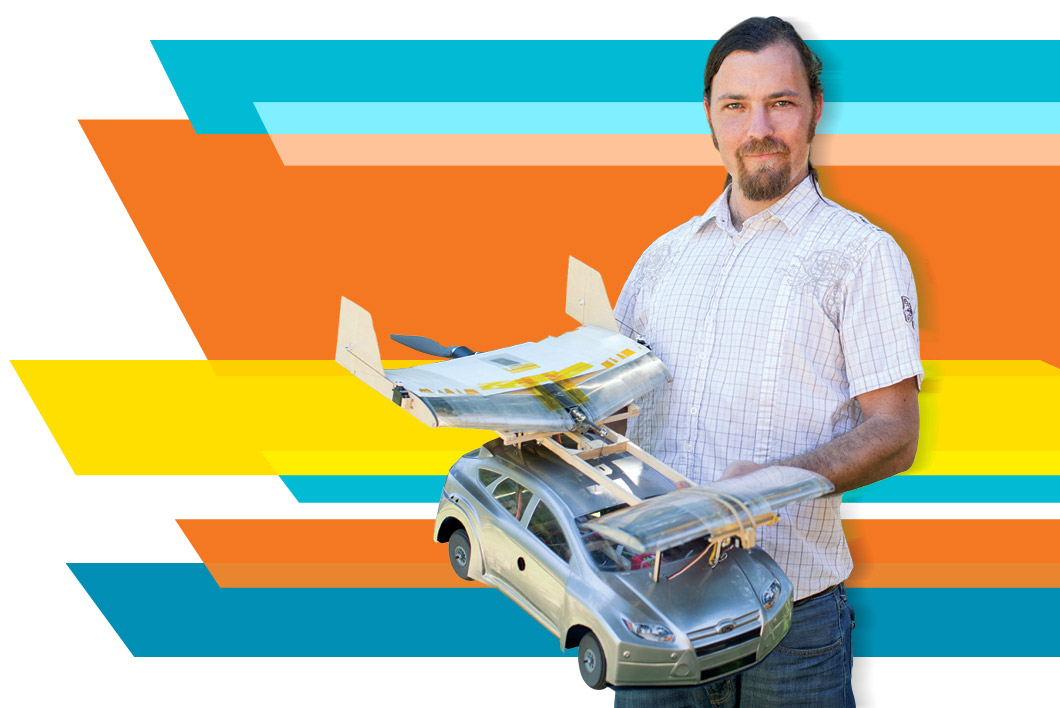The Road Before Take-off
Third-generation aeronautics enthusiast Jeremiah McCoy ’04 designs a flying car.
SAY THE WORDS “FLYING CAR” and it’s hard not to think of George Jetson zipping around in his glass-domed buggy, leaving an exhaust trail of pristine concentric circles. Even though aircraft maneuver on pavement every day, the concept of a flying car still seems pretty outlandish. But getting a car airborne isn’t rocket science. Designing a flying car that meets the imposing array of traffic, aeronautical and safety regulations to operate on roads and in the air is another beast all together.
Jeremiah McCoy ’04 is a third-generation aeronautics man who has been rolling around the idea of a flying car since he was in high school. To create the market for it, he is counting in equal part on the allure of the skies as well as the futility and frustration all drivers face. “If you’ve ever spent time just sitting there in Los Angeles commuter traffic, a flying car starts looking pretty good,” he says. “It will get you from point to point. To fly now, you have to get in a car, drive to the airport, fly to another airport, get into another car, drive to where you are going and then reverse that for the return trip. With a flying car you drive to the airstrip, take off, land and drive straight to your destination.”

McCoy’s grandfather, Col. Howard M. McCoy, was a command pilot and chief of the Propeller Unit of the Army Air Force during World War II, where he designed propellers for warplanes. Later, Col. McCoy was appointed chief of air technical intelligence. “He was one of the first people to work on reverse engineering the V-1 bombs that were launched at London,” McCoy says.
Jeremiah’s father, a pilot and sailor, built exotic kit aircraft in the family garage in Colorado. When Jeremiah was born, his parents were living on a boat in the Caribbean that his father had built, and on return visits, his father would fly a single-engine Cessna between islands. Jeremiah’s introduction to piloting came at the age of 12, during one of those Caribbean trips. “I remember sitting in my dad’s lap in the copilot seat. There were dual controls, and he let me take hold of the steering wheel and fly the plane over the sea. It was beautiful.”
During the last 10 years, McCoy has worked in the aerospace and defense industry as a test engineer, while in his spare time focusing his attention on creating a commercially viable flying car in a burgeoning field of potential competitors. There are several teams hoping to develop and market a flying car, each with unique design features. One is an elongated sports car with a single propeller and wings that fold back onto the roof like a pair of surfboards. Another team has adopted a tilt rotor design, like that of the controversial V-22 Osprey. A third is a gyrocopter—a helicopter with a smaller, conventional propeller in the rear for propulsion.
They say that aviation proceeds one innovation at a time. This is my contribution to the state-of-the-art.
– JEREMIAH MCCOY ’04
McCoy has come up with some innovations that he hopes will help him leapfrog the pack. First, he has invented and patented a telescoping wing mechanism, so the wings can retract into a highly compact airfoil shape. “They say that aviation proceeds one innovation at a time,” says McCoy. “This is my contribution to the state-of-the-art. It reduces the storage space of the wings by 75 percent.” He is also making the vehicle a threewheeler, rather than a regular four-wheel car. “It’s a lot easier to make a three-wheeler street legal,” McCoy points out. “My design would be governed by motorcycle regulations. They aren’t as stringent as the safety regulations for cars, which need crumple zones, airbags and other features that add weight. Once we get the prototype going, we can adapt it to a car.”
The third and maybe most important part of the design in terms of the long-term feasibility of the enterprise is that the entire flying apparatus will be available as a modular rack system, so it could be mounted wholesale onto a different type of car. “The rack system reduces weight, and most sports cars are already aerodynamic. The modular mechanism could be licensed and sold to automobile manufacturers to use on their own cars.”
The road to a final design can be bumpy, McCoy acknowledges. Early in 2015, a failure occurred during a flight test of the original prototype. “The canard design that I had come up with proved to be too unstable for such a small model, and we had a crash,” says McCoy. “Since then, I’ve redesigned the scale model to have a more traditional tail, although we have kept the telescoping wings and the modular approach.”
It hasn’t been fully built yet, but the design is complete, and the parts are being made. The newer version of the prototype is designed for mass production, to be sold as a kit. McCoy’s focus now is tapping into the model/RC hobbyist market before seeking funds for a full-scale, life-sized flying car.
